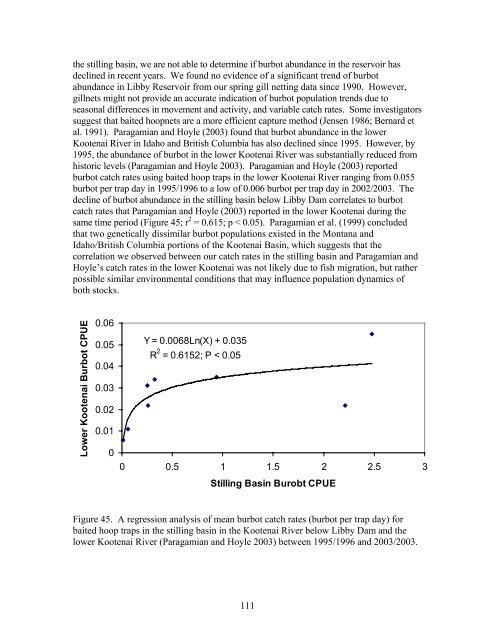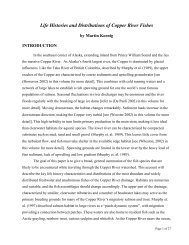Mitigation for the Construction and Operation of Libby Dam
Mitigation for the Construction and Operation of Libby Dam
Mitigation for the Construction and Operation of Libby Dam
Create successful ePaper yourself
Turn your PDF publications into a flip-book with our unique Google optimized e-Paper software.
<strong>the</strong> stilling basin, we are not able to determine if burbot abundance in <strong>the</strong> reservoir has<br />
declined in recent years. We found no evidence <strong>of</strong> a significant trend <strong>of</strong> burbot<br />
abundance in <strong>Libby</strong> Reservoir from our spring gill netting data since 1990. However,<br />
gillnets might not provide an accurate indication <strong>of</strong> burbot population trends due to<br />
seasonal differences in movement <strong>and</strong> activity, <strong>and</strong> variable catch rates. Some investigators<br />
suggest that baited hoopnets are a more efficient capture method (Jensen 1986; Bernard et<br />
al. 1991). Paragamian <strong>and</strong> Hoyle (2003) found that burbot abundance in <strong>the</strong> lower<br />
Kootenai River in Idaho <strong>and</strong> British Columbia has also declined since 1995. However, by<br />
1995, <strong>the</strong> abundance <strong>of</strong> burbot in <strong>the</strong> lower Kootenai River was substantially reduced from<br />
historic levels (Paragamian <strong>and</strong> Hoyle 2003). Paragamian <strong>and</strong> Hoyle (2003) reported<br />
burbot catch rates using baited hoop traps in <strong>the</strong> lower Kootenai River ranging from 0.055<br />
burbot per trap day in 1995/1996 to a low <strong>of</strong> 0.006 burbot per trap day in 2002/2003. The<br />
decline <strong>of</strong> burbot abundance in <strong>the</strong> stilling basin below <strong>Libby</strong> <strong>Dam</strong> correlates to burbot<br />
catch rates that Paragamian <strong>and</strong> Hoyle (2003) reported in <strong>the</strong> lower Kootenai during <strong>the</strong><br />
same time period (Figure 45; r 2 = 0.615; p < 0.05). Paragamian et al. (1999) concluded<br />
that two genetically dissimilar burbot populations existed in <strong>the</strong> Montana <strong>and</strong><br />
Idaho/British Columbia portions <strong>of</strong> <strong>the</strong> Kootenai Basin, which suggests that <strong>the</strong><br />
correlation we observed between our catch rates in <strong>the</strong> stilling basin <strong>and</strong> Paragamian <strong>and</strong><br />
Hoyle’s catch rates in <strong>the</strong> lower Kootenai was not likely due to fish migration, but ra<strong>the</strong>r<br />
possible similar environmental conditions that may influence population dynamics <strong>of</strong><br />
both stocks.<br />
Lower Kootenai Burbot CPUE<br />
0.06<br />
0.05<br />
0.04<br />
0.03<br />
0.02<br />
0.01<br />
0<br />
Y = 0.0068Ln(X) + 0.035<br />
R 2 = 0.6152; P < 0.05<br />
0 0.5 1 1.5 2 2.5<br />
Stilling Basin Burobt CPUE<br />
3<br />
Figure 45. A regression analysis <strong>of</strong> mean burbot catch rates (burbot per trap day) <strong>for</strong><br />
baited hoop traps in <strong>the</strong> stilling basin in <strong>the</strong> Kootenai River below <strong>Libby</strong> <strong>Dam</strong> <strong>and</strong> <strong>the</strong><br />
lower Kootenai River (Paragamian <strong>and</strong> Hoyle 2003) between 1995/1996 <strong>and</strong> 2003/2003.<br />
111
















